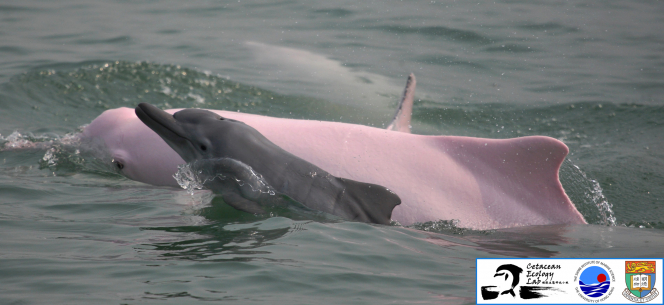Media
The “Hong Kong population” of Chinese white dolphins re-defined:
The latest HKU study clarifies how many dolphins there are in Hong Kong waters
31 Mar 2017
The latest study by researchers at the University of Hong Kong (HKU) delivered the first-ever comprehensive population assessment of the Chinese white dolphins that inhabit Hong Kong waters, and what they found differs from the common public belief. In fact “it differs very substantially from the estimates reported in Hong Kong for the past many years,” said Dr. Leszek Karczmarski, Associate Professor at the Swire Institute of Marine Science and School of Biological Sciences, HKU, who has instigated and supervised this study. “Contrary to statements frequently repeated by various Hong Kong media, there is no such thing as ‘Hong Kong dolphin population’ ” he added.
“The dolphins seen in Hong Kong waters represent an integral part of the Pearl River Estuary (PRE) population; they are not aware of the administrative border between Hong Kong and Mainland waters, frequently traverse these waters, and there are at least 368 dolphins that rely on Hong Kong waters as part of their home range,” said Mr. Stephen Chan, a Ph.D. student in Dr. Karczmarski's Lab and the lead author of the study that was published on Wednesday (March 29) in the peer-reviewed journal PLOS ONE (link: http://journals.plos.org/plosone/article?id=10.1371/journal.pone.0174029).
How does it compare to the frequently advocated estimates of the apparently last remaining 60-something Hong Kong dolphins, reported by the dolphin monitoring program contracted annually by Hong Kong’s Agriculture, Fisheries and Conservation Department (AFCD)?
Dr. Karczmarski explained: “There are several reasons for these considerable differences. The AFCD-funded monitoring program applies a sampling technique called line transect sampling which differs from photographic mark-recapture technique applied by the HKU team. These two techniques address a different albeit mutually relevant research question, and therefore the estimates they generate have different meanings, each with their own merits. While the line-transect approach estimates the number of animals that are present in the area at a given time, the mark-recapture analyses estimate the overall number of animals that use Hong Kong waters during the study period. The heart of the matter is how one interprets the results, and this is the part that has been highly problematic with the AFCD’s data over past years.”
Mr Chan said: “Take the number of people in Hong Kong for example, counting every person in Hong Kong on any particular day does not represent the population of Hong Kong, because there are lots of tourists, visitors and even residents travelling in and out. Similarly, counting dolphins without acquiring their identities can tell the number of dolphins in an area during that particular time, but it is not the same as quantifying the population as some dolphins may be just outside the border at the time.”
The HKU team therefore applied the photo-identification mark-recapture technique, to acquire the individual identity of dolphins. “Dorsal fins of dolphins bear natural markings which tell us who they are, just like our fingerprints,” said Mr. Chan.
The study concludes that the numbers of “Hong Kong dolphins” have long been misinterpreted and wrongly advocated, and has underrepresented the real number of dolphins that depend on Hong Kong coastal waters for their daily lives. As result, the Hong Kong management authorities have failed to adequately monitor the population processes and could not detect the change in population figures up until the dolphin numbers dropped alarmingly low.
Dr. Karczmarski emphasizes that the higher number of dolphins indicated by the HKU study “does not imply that the dolphins are better off than what the AFCD reports (just over 60 individuals) suggest. It simply shows the critical importance of Hong Kong coastal habitats to the entire PRE dolphin population; yet another indication that these habitats, especially of west-southwest Lantau Island, should be given the highest conservation priority.”
Dr. Thomas Jefferson of Clymene Enterprises, California, USA, who in mid-1990s conducted early studies of Chinese white dolphins in Hong Kong, has congratulated the HKU team on their “nice piece of work!” and added that “it brings up many important points about some of the deficiencies of the current long-term monitoring program that the Hong Kong Government uses to manage these dolphins in Hong Kong.” Dr. Jefferson was not involved in the study, but has independently reviewed the article upon the journal’s request.
It has taken the HKU team over 6 years of intensive field surveys with every good-weather day spent out at sea photographing dolphins. It has been a very labour-intensive project, says Dr. Karczmarski, and we had to start from a scratch, with none of the earlier AFCD data made available to us, but our goal was well worth the effort and we can only hope that the Hong Kong management authorities will make a good use of the study to revise the current population monitoring strategy.
A previous study by Dr. Karczmarski and his collaborators, published in 2012 in the journal Biological Conservation (link: http://www.sciencedirect.com/science/article/pii/S0006320712000055) indicated that the PRE dolphin population, including Hong Kong, is rapidly declining in a rate of 2.5% per year; meaning that if this process continues, more than 70% of the current population will be lost in the next 60 years. Another recent study by both Dr. Karczmarski and Mr. Chan, published last month in the journal Scientific Reports (link: http://www.nature.com/articles/srep42900) pointed out that the current conservation measures in the PRE are severely inadequate and the PRE dolphin population is doomed to become extinct unless management pitfalls are acknowledged and new effective conservation measures rapidly reverse the current population trend.
The study was supported by the Research Grants Council of Hong Kong (RGC) and Ocean Park Conservation Foundation Hong Kong (OPCFHK).
For media enquiries, please contact Dr. Leszek Karczmarski (Email: leszek@hku.hk) and Mr. Stephen C.Y. Chan (Email: chancy3@hku.hk), both at The Swire Institute of Marine Science, School of Biological Sciences, The University of Hong Kong.

